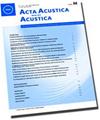The Ambisonic Recordings of Typical Environments (ARTE) Database
Q1 Arts and Humanities
引用次数: 21
Abstract
Everyday listening environments are characterized by far more complex spatial, spectral and temporal sound field distributions than the acoustic stimuli that are typically employed in controlled laboratory settings. As such, the reproduction of acoustic listening environments has become important for several research avenues related to sound perception, such as hearing loss rehabilitation, soundscapes, speech communication, auditory scene analysis, automatic scene classification, and room acoustics. However, the recordings of acoustic environments that are used as test material in these research areas are usually designed specifically for one study, or are provided in custom databases that cannot be universally adapted, beyond their original application. In this work we present the Ambisonic Recordings of Typical Environments (ARTE) database, which addresses several research needs simultaneously: realistic audio recordings that can be reproduced in 3D, 2D, or binaurally, with known acoustic properties, including absolute level and room impulse response. Multichannel higher-order ambisonic recordings of 13 realistic typical environments (e.g., office, cafè, dinner party, train station) were processed, acoustically analyzed, and subjectively evaluated to determine their perceived identity. The recordings are delivered in a generic format that may be reproduced with different hardware setups, and may also be used in binaural, or single-channel setups. Room impulse responses, as well as detailed acoustic analyses, of all environments supplement the recordings. The database is made open to the research community with the explicit intention to expand it in the future and include more scenes.典型环境的双声录音(ARTE)数据库
日常聆听环境的特点是远比在受控实验室环境中通常采用的声刺激更复杂的空间、频谱和时间声场分布。因此,听觉环境的再现对于一些与声音感知相关的研究途径变得非常重要,例如听力损失康复、声景、语音交流、听觉场景分析、自动场景分类和室内声学。然而,在这些研究领域中用作测试材料的声环境记录通常是专门为一项研究设计的,或者是在定制数据库中提供的,这些数据库不能在其原始应用之外普遍适用。在这项工作中,我们介绍了典型环境的双声录音(ARTE)数据库,它同时解决了几个研究需求:可以以3D, 2D或双耳方式再现的真实录音,具有已知的声学特性,包括绝对声级和房间脉冲响应。对13种现实典型环境(例如,办公室、cafè、晚宴、火车站)的多通道高阶双声录音进行处理、声学分析并进行主观评估,以确定其感知身份。录音以通用格式传送,可以用不同的硬件设置复制,也可以在双耳或单通道设置中使用。房间脉冲响应,以及所有环境的详细声学分析,补充了记录。该数据库向研究界开放,明确打算在未来扩展它,包括更多的场景。
本文章由计算机程序翻译,如有差异,请以英文原文为准。
求助全文
约1分钟内获得全文
求助全文
来源期刊
CiteScore
2.60
自引率
0.00%
发文量
0
审稿时长
6.8 months
期刊介绍:
Cessation. Acta Acustica united with Acustica (Acta Acust united Ac), was published together with the European Acoustics Association (EAA). It was an international, peer-reviewed journal on acoustics. It published original articles on all subjects in the field of acoustics, such as
• General Linear Acoustics, • Nonlinear Acoustics, Macrosonics, • Aeroacoustics, • Atmospheric Sound, • Underwater Sound, • Ultrasonics, • Physical Acoustics, • Structural Acoustics, • Noise Control, • Active Control, • Environmental Noise, • Building Acoustics, • Room Acoustics, • Acoustic Materials and Metamaterials, • Audio Signal Processing and Transducers, • Computational and Numerical Acoustics, • Hearing, Audiology and Psychoacoustics, • Speech,
• Musical Acoustics, • Virtual Acoustics, • Auditory Quality of Systems, • Animal Bioacoustics, • History of Acoustics.

 求助内容:
求助内容: 应助结果提醒方式:
应助结果提醒方式:


